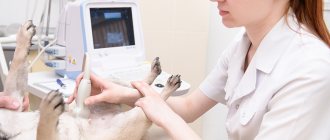Finally, the necessary examinations have been completed, a suitable partner for the female has been found, and the puppies have been successfully conceived. Now your task is to carefully monitor the well-being of the expectant mother, as well as the development of the fetus.
Pregnancy in bitches lasts on average 60-65 days (9 weeks) from the moment of ovulation and fertilization. If the dog is sick, depressed, or is pregnant for more than 65 days, a caesarean section may be necessary.
Determining the exact date of pregnancy from the first day of mating is in most cases problematic. That is why it is advisable to carry out special tests to determine at what point the egg was released from the ovary into the fallopian tube.
This is explained by the fact that sperm survive several days (up to 5) in the female’s womb. They have a long development path to go through - from the egg to the formed fetus.
In order for your dog’s pregnancy to go smoothly and not be complicated by some unpleasant moments, it is very important to know how the fetus develops week by week. This is why the pregnancy calendar for dogs becomes an excellent tool for novice dog breeders.
First week (0-7 days)
In this phase, mating, fertilization occurs, and the countdown of pregnancy begins. The following point must be taken into account: ovulation does not always occur after the first mating. That is why you need to prepare for a control mating, which is carried out 48 hours after the first one.
Determining whether a female has become pregnant is problematic, so it is necessary to monitor body temperature. Sometimes an animal, just like a person, may experience morning sickness.
It is very important to monitor the dog’s health, provide it with good care and high-quality balanced feeding.
How to tell if a dog is pregnant?
After mating, it is impossible to immediately recognize whether conception has taken place or not, since no special changes will occur. After 14 days, some females may develop a depressed mood, a decrease or complete indifference to food. This behavior is completely normal, including when the dog becomes pregnant. Starting from this period and after 30 days, the animal’s nipples swell, changing color to a bright pink hue.
However, behavior, sleep and food cravings remain unchanged. During weeks of pregnancy in dogs, the owner needs to increase the number of feedings to three feedings a day. Please note that during pregnancy, increased portions of fermented milk products and foods containing large amounts of protein should be important in the diet.
From the second month you can observe an increase in the abdomen near the ribs. 20 days before the upcoming birth, the female gains weight at a rapid pace, it is important to monitor her nutrition. When the dog is in a lying position, you can clearly see the movement of the puppies. Do not forget also about walking the dog, but without any stress, so as not to affect the development of future offspring.
Third week (14-21 days)
Embryos, whose size is already at least 1 centimeter, actively move towards the uterus and are evenly distributed in it. From the mother's body through the placenta, they receive nutrients, without which normal life activity is impossible. The next stage of intrauterine development begins - the organs, central nervous system, brain, spine, hind and front legs are formed in future puppies.
It is necessary to exclude the influence of external unfavorable factors on the expectant mother, as they can also affect the offspring. Vaccinations and other interventions in the female’s body are not carried out during this period.
On days 18-19, the size of the fruit reaches 2 millimeters. Embryos take on the body shape found in mammals.
On the 20th day, the size of the embryos is up to 4 millimeters.
The female may experience mood swings, loss of appetite, and swollen mammary glands. Remembering that the dog must provide nutrients not only to its body, but also to its future offspring, feed it as usual and control its appetite.
Preparing for childbirth
About a week before the expected date of birth, you need to take care of a comfortable place for the “nest” in which the birth will take place and the puppies will be with their mother. The structure must be closed on 4 sides so that the animal feels calm and safe. The house must be positioned so that the owner and veterinarian can gain access to the mother and babies if necessary.
Be sure to prepare items that will be useful during the birth process and immediately after it. These include:
- Sterile bandages and gauze (to wipe babies);
- Absorbent or rubberized diaper (on the floor in the house);
- Iodine, brilliant green, cotton pads for treating the umbilical cord;
- Medical rubber “bulb” (to remove mucus from the puppy’s nose);
- Sterile scissors and threads (for tying and cutting the umbilical cord);
- Scales and a notebook to record information about the sequence of appearance and weight of the puppies;
- Multi-colored woolen threads (tie around the neck to distinguish the babies);
- formula for newborn pets and a heating pad, in case of complications of the mother’s condition or her reluctance to feed.
Detailed article on the topic: “Features of childbirth in a dog: preparation, symptoms, care.”
The length of time you wait for puppies depends not only on their number, but also on the size of the female, her age and how pregnant she is. By following the recommendations for caring for the mother, as well as observing her condition, you can monitor the development of the babies, as well as prepare everything necessary for their birth in time.
4.7 / 5 ( 3 voices)
Fourth week (21-28 days)
A veterinarian and an experienced dog breeder can feel the fetus by palpating the abdomen. In embryos, the organs of vision develop, the muzzles take on their usual shape, and the spine becomes stronger. The fruit size is up to 1.5 centimeters in length.
In veterinary medicine, this period of pregnancy is considered the most important, since puppies are especially vulnerable to the development of abnormalities and damage. The dog must be limited in physical activity and physical activity. There is a need for nutritional correction; additional nutritional supplements are introduced into the diet.
The female's nipples become rough, and a small amount of clear fluid may be released from the vagina.
Fifth week (28-35 days)
During this phase, the amount of amniotic fluid increases, which makes it difficult to palpate the fetus in the dog’s stomach. Puppies are no longer so susceptible to developing abnormalities. They develop claws, whiskers, and genitals. At 30-32 days, the size of embryos is up to 2 centimeters, at 33-34 - 2.7 cm. Body weight is 20% of the weight of newborn puppies.
On the 33rd day, the palate tightens or completely closes. If this does not happen, the puppy is born with a pathology incompatible with life - a cleft palate.
The female gains weight, this is due to the presence of amniotic fluid and the rapid development of the fruits. The dog should receive enhanced nutrition, fractional feeding, in small portions. Under no circumstances should you give your animal medications or chemicals, as they will inevitably harm the offspring.
During this period, it is advisable to conduct an ultrasound examination to determine how the future offspring develops and whether they have any abnormalities. An ultrasound can also determine the number of puppies.
False pregnancy in a dog
Failure of the reproductive system in dogs is a fairly common occurrence in the animal’s body, which must be determined as quickly as possible in order to eliminate undesirable consequences for the body. The disorder occurs in unmated females after the period of estrus, and also as a result of unsuccessful mating. As a result of such mating, the same accumulation of hormones is formed in the animal that is observed in a fertilized bitch. The key signs of false fertilization are quite similar to the symptoms of a dog’s real pregnancy week by week and look like:
- enlargement and change in color of nipples;
- discharge in the form of colostrum;
- the volume of the loop changes in size;
- loss of appetite;
- searching for a place for future offspring.
As a rule, signs of false fertilization disappear after 2 weeks. There is no need to worry about the dog’s well-being, since nothing threatens the pet’s health.
It is incredibly difficult to distinguish a false pregnancy from a real one, since there is discharge and corresponding behavior of the animal. Therefore, the main criterion is the absence of movement of the puppies in the stomach. However, the easiest way to eliminate such a pregnancy is to use modern ultrasound diagnostics.
Week six (35-42 days)
The female's belly increases greatly in size, and now her pregnancy is an obvious fact for everyone. Every day it will grow. Changes also occur in the female’s body: the nipples become larger, their shade changes - it becomes darker.
During this phase, puppies begin to develop their individual characteristics. Skin pigmentation determines coat color. On days 35-39, fetal growth is 3.5 cm, by the 40th day it increases to 5 centimeters.
The number of feedings of the female increases, but if the dog wants to eat, you should not refuse it. At the same time, overfeeding and excessive weight gain should be avoided. A smart step would be to include multivitamins and special food for puppies in the menu, but only a veterinarian can say what exactly will be beneficial for your dog.
The owner can already prepare in advance the place where the dog will give birth. It should be warm and comfortable. Expectant mothers need to be gradually prepared for a cozy place, and her desire to relax in it should be encouraged.
Proper care for a pregnant dog
Hygienic measures for the animal include examinations every day, cleaning the fur, and checking the skin. In the second half of gestation, a pregnant dog sometimes has mucus discharge from the birth canal. In most cases, the dog removes the discharge by licking itself. In rare cases, when the dog is still young and this is her first pregnancy, she may not do this, then you should simply clean the area with ordinary clean water. However, there is no point in cleaning the animal 2 weeks before giving birth.
When the pet has not received timely treatment with deworming drugs before mating, in this case the process must now be delayed for 14 days after the birth has been resolved. Remember that during the period of breeding dogs, it is also necessary to abandon such activities and any other medications, including flea treatment. Keep an eye on your dog so that it does not have contact with sick or stray animals.
There are times when a dog can relieve itself in an apartment. This is a fairly common occurrence during pregnancy, since the dog sometimes cannot control this process. You shouldn’t take this aggressively and take your anger out on the dog.
Indeed, in the late stages of pregnancy, the animal needs special attention and care. Try to plan and organize your upcoming birth location as quickly as possible. The site should not only be comfortable for the animal, but also free from drafts.
Also try to arrange the place so that there is free access to the dog to assist during childbirth. Gradually accustom the dog to the area so that in the future it will not look for another place to give birth. An important place in the later stages is given to walks, since spending time in the fresh air cannot be reduced.
Walking will only benefit the dog. In the first month of pregnancy, training is not contraindicated, however, starting from the second month, protect the bitch from jumping and running.
Vitamin complex
Vitamins have a beneficial effect on metabolism throughout the body. The prescribed complex of essential beneficial microelements are catalysts that promote better absorption of food. Of course, animals need a certain amount of vitamins, especially during pregnancy. Most of the vitamins enter the body from food, but not always in the required dose, which is why there is an urgent need for additional supply to the body.
During pregnancy, the pet's menu should be enriched with additional elements, which can be prescribed by the doctor if necessary. The development of puppies will require a lot of minerals and vitamins, which the dog sometimes lacks. Therefore, a good option for the healthy development of puppies is additional vitamins prescribed by a veterinarian.
In the first month after mating, veterinarians do not advise changing the pet’s menu, and the introduction of vitamins is not yet required. Ordinary habitual nutrition will be able to fully guarantee the basic needs of the body at this stage. It’s a good idea to add a few yolks per week to your dog’s diet. The menu needs to include more protein foods and lean meats, for example, beef.
After the first month of pregnancy, it is recommended to significantly increase the dosage of food and switch to feeding 3 times a day. It is necessary to add a small amount of fish oil to food, which guarantees a supply of nutrients during pregnancy. In addition, you will need to use vitamins A, B, D and E. Together with vitamin D, large amounts of Ca should be used - an important element in the formation of the skeleton of puppies and the maintenance of the mother’s body as a whole.
In cases where large offspring are expected, a special need appears for lactate and glycerophosphate. However, in addition to vitamins, you shouldn’t lose sight of simple foods. Pay attention to the benefits of dairy food, which is necessary for a pregnant bitch. They have a huge amount of calcium and phosphorus, as key elements that a dog cannot do without during the gestation process.
Seventh week (42-49 days)
The puppies develop safely and quickly; at this stage they are already fully formed.
The female sheds heavily, especially in the abdominal area. This is a normal physiological phenomenon and should not cause concern. In this way, the expectant mother’s body prepares for the birth of babies.
Complementary feeding with special food for puppies can be omitted, and the female can be transferred to the usual method of feeding, but the food must be nourishing, enriched with vitamins and nutrients.
Eighth week (49-57 days)
During this period, the owner needs to be on alert, as puppies can be born at any minute. The bone tissue of puppies is already very strong, the teeth are formed, and their growth corresponds to the size of newborns. An ultrasound will accurately determine the number of fetuses.
Physical activity and stress accelerate this process, so it is necessary to surround the expectant mother with care and attention, make sure that she moves less and rests more. It is advisable for the puppies to stay in their mother's belly for a week. When the dog is lying down, you can feel the puppies to see how they move in the uterus.
The female begins to secrete colostrum from her nipples, which is a harbinger of childbirth. She worries, looks for a comfortable, quiet place for childbirth, lies most of the time, getting up only to eat and perform natural needs.
Visit to the veterinarian
After detecting the listed signs, make an appointment with a veterinary clinic. Plan a visit no earlier than a month after mating. By this time, relaxin, a sex hormone, will appear in the blood of the expectant mother, on the basis of which an interesting position is confirmed.
Determining the number of fruits
In addition to examination, palpation and blood tests, diagnosis involves ultrasound and x-rays. These procedures help determine the exact number and condition of the fruits, but not earlier than the beginning of the 2nd month.
Exclusion of pathologies
A visit to the veterinary clinic is recommended even if your four-legged pet is in good health. Not all pathologies are determined visually. Diagnostic procedures help to detect hidden complications and prevent their development.
Ninth week (57-59 days)
During this phase, the puppies' muzzle, paws, tail and belly are covered with soft, light hair. The body and internal organs are entering the final stage of formation. Since the puppies are already quite large, they fill the entire body of the uterus and practically stop moving.
The dog behaves restlessly, is worried, and tries to dig holes. The owner can expect the first contractions and the pet.
The appearance of the long-awaited offspring usually occurs on the 65th day. Representatives of large breeds may give birth earlier - on the 63rd day. This is not considered an anomaly.
The owner must make sure that everything is prepared for this important process. A dog should not need for anything. The bitch avoids contacts, tries to protect herself from the outside world. There is no need to force feed, as appetite decreases before childbirth. A dog should eat when it wants it.
The approach of labor is determined by measuring temperature. The normal body temperature of an adult dog is on average 37-38.9 degrees. 12-24 hours before birth it decreases by 1-2 degrees. A characteristic sign of labor is the discharge of amniotic fluid, which is a viscous liquid of a light yellow color.
During this period, the corpus luteum ruptures and the cervix opens. Hormonal changes occurring in the body provoke increased contractions of the uterus and contractions. Puppies are born one at a time, after a certain period of time. Their bodies are covered with fur, their eyes are tightly closed.
Possible complications
If you notice any alarming symptoms, including a significant deviation from the planned date, call your veterinary clinic immediately. It is better to be wrong in your guesses than to allow the death of your four-legged pet and her babies.
Ectopic pregnancy
The development of embryos outside the uterus is fraught with death due to internal ruptures and bleeding. It is accompanied by pain and bloody discharge from the uterus. If the animal whines and blood flows from its loop, call a doctor.
False pupishness
False whelping, or false pregnancy, can be easily determined independently only by the absence of mating. This condition is accompanied by similar symptoms, but instead of labor, it can result in mastitis or other complications. Due to the likelihood of such an outcome, veterinarians recommend not to refuse blood donation, ultrasound and x-rays.
Frozen pregnancy
Partial or complete death of embryos is fraught with mummification with subsequent intoxication of the body. If the dead fetuses do not come out on their own, they are removed by artificial stimulation of the uterus or by sterilization.
If the dog paces
A delay of more than 10 days is an alarm bell. In addition to the death of the fetus, the reason may lie in a delay in its development, pathologies of the genital organs of the bitch, or other diseases of the four-legged woman in labor. Healthy babies are removed by caesarean section.











